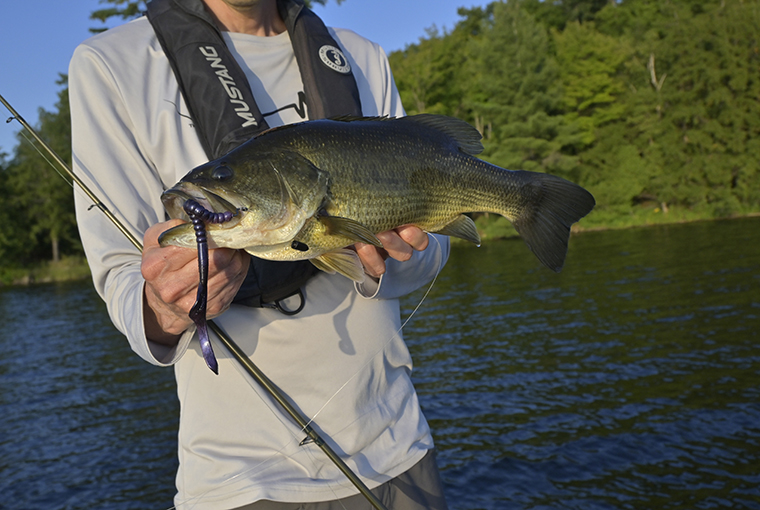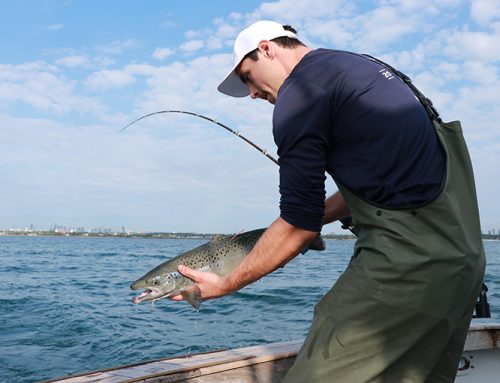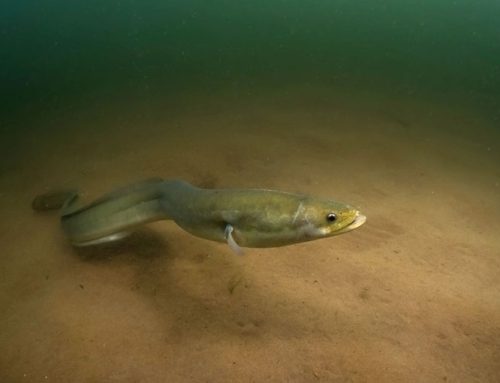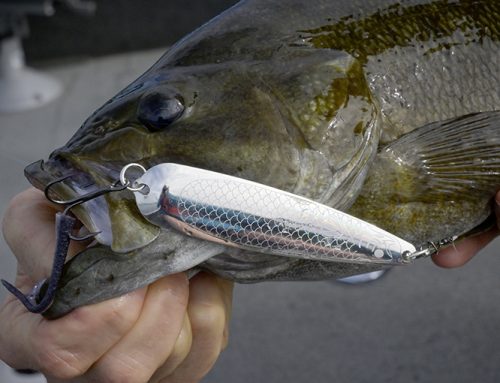
The bass tactics merry-go-round is coming full circle, folks. Big, long plastic worms have always been a reliable bait for bass, but anglers (myself included) mistakenly sidelined them for trending, chunky plastics—nothing against beefy beavers, creatures, and craws, of course. Here’s a worm refresher and some encouragement to tie on these elongated soft baits more often this season.
Whispers of worming success
Over the last few years, I’ve been hearing more reports of local anglers smashing largemouth bass using seven-to-10-inch worms. One friend, after a few tough late-summer outings, called with vindication in his voice. “Want to know the hot bait? A Texas-rigged, 10-inch Berkley Power Worm. I threw everything at them, then, finally got them to bite on that thing.”
My buddy’s report didn’t take me by surprise as it came on the heels of a family fishing vacation when Grady, my son, decided it was time to learn how to catch largemouth from thick weeds. Without hesitation, I set him up with a Texas-rigged seven-inch, black Berkley PowerBait Power Worm on a 3/0 EWG with a 3/8-ounce bullet weight.
Welcome to old-school bassin’, my boy!
Since it was August, we pitched worms into and along deep, outside weed edges. Being addicted to all things baseball, Grady has the swing biomechanics to rock a solid hook-set and it didn’t take him long to start pulling bass out of the grass.
Deep prospecting
A Texas-rigged seven-inch-plus worm is great for working various spots where largemouth might live around deep weeds. With a heavy enough weight, its streamlined profile easily punches through a thick grass canopy, for instance. Its get-noticed size and weedless properties make it an all0purpose presentation equally effective for prospecting deep weed edges, along with the surrounding deeper water with little concern of hang-ups.
Crawling out into the beyond
What’s proving fascinating (and fun!) is the number of big fish my friends and I are catching casting worms into deeper water adjacent to deep weedlines. I got in the habit of making these “what if” casts years ago thanks to a lesson from “Big” Jim McLaughlin about how productive, yet overlooked, this band of water can be for big bass.
Big largemouth have a habit of milling around and looking for food on these slow tapering areas, which bridge the last bastions of vegetation and drop-off ledges. Find an isolated structural element, like a rock spine, or weed clump out here and you’ve hit pay dirt.
To peg or not to peg?
Using a peg or weight stopper to keep the sinker snug against a worm’s nose helps the package slide through thick weeds and wood. An unpegged weight has its merits, though, in open areas. The lead or tungsten weight finds bottom first, while the worm either slowly sinks or hovers, depending on its buoyancy, then swims to meet the sinker once line tension is applied.
Deep worming smallmouth
A big smallmouth can easily fit a seven- to 10-inch worm in its yap and still have room for dessert. Expect bronzeback encounters when prospect ing deep weedbeds and adjacent open water.
My deep-worm program looks a little different for smallmouths. I “downsize” to five- to seven-inch baits. Things like the Berkley Magnum Hit Worm and Shaky Snake (discontinued), Roboworm Fat Straight Tail Worm, and Z-Man FattyZ and SMH WormZ.
I fish these on jig-worm, mushroom, or shaky-head jigs. The latter allows for hiding the hook point in the plastic for a fairly weedless package and helps position the worm in a tail-up position.
A quarter-ounce jig is my go-to. Although, a slower falling 3⁄16 can pique smallmouth curiosity. Working deeper water in rough conditions can require a 5 ⁄16-ounce jig.
I have the best success using shaking and dragging retrieves. Snapping has its moments, but regular contact with the floor appears to be the most reliable approach.
Deep worming wrap-up
Try worm rigs this season. If your home water is anything like mine, a lot of deep-living bass will be eager to eat big, long worms.
My picks on worms for Texas-rigging
You can work a Texas-rigged worm in various ways: crawl it along the bottom, use a swim-and-kill retrieve, or lift it up a couple feet and then let it fall.
Berkley Power Worm: Its ribbontail swims naturally on the fall.
StrikeKing Rage Cut-R Worm: Its tail design gives it a fast flickering action
Z-Man’s 7.25-inch Mag Fattyz: It has a bulbous tail for an exaggerated tail-quivering action.
Originally published in the June-July 2024 issue of Ontario OUT of DOORS






Leave A Comment